Report: Sydney Metro Northwest Project Overview and Analysis
VerifiedAdded on 2023/01/19
|15
|3413
|83
Report
AI Summary
This report provides a comprehensive overview of the Sydney Metro Northwest Project. It begins with a detailed project overview, including the overall budget, social and economic rationale, key statistics, funding mechanisms, and key stakeholders. The report then delves into a thorough risk analysis, identifying potential risks such as delays in approvals, conflicts between companies, land acquisition disputes, funding issues, technical problems, and unavoidable circumstances. Finally, the report presents a risk mitigation plan, offering strategies to address each identified risk. The plan outlines specific actions to be taken to minimize the impact of potential issues, ensuring the project's success. This report is a valuable resource for understanding the complexities of large-scale infrastructure projects and the importance of proactive risk management. The report highlights the project's significant impact on Sydney's public transport system and the economy, and it is a testament to the author's analytical and problem-solving skills. The report is designed to be a useful resource for students studying project management, business development, and related fields, with a focus on practical application and real-world examples.

Running head: SYDNEY METRO NORTHWEST PROJECT
Sydney Metro Northwest Project
Name of the Student
Name of the University
Author’s note
Sydney Metro Northwest Project
Name of the Student
Name of the University
Author’s note
Secure Best Marks with AI Grader
Need help grading? Try our AI Grader for instant feedback on your assignments.
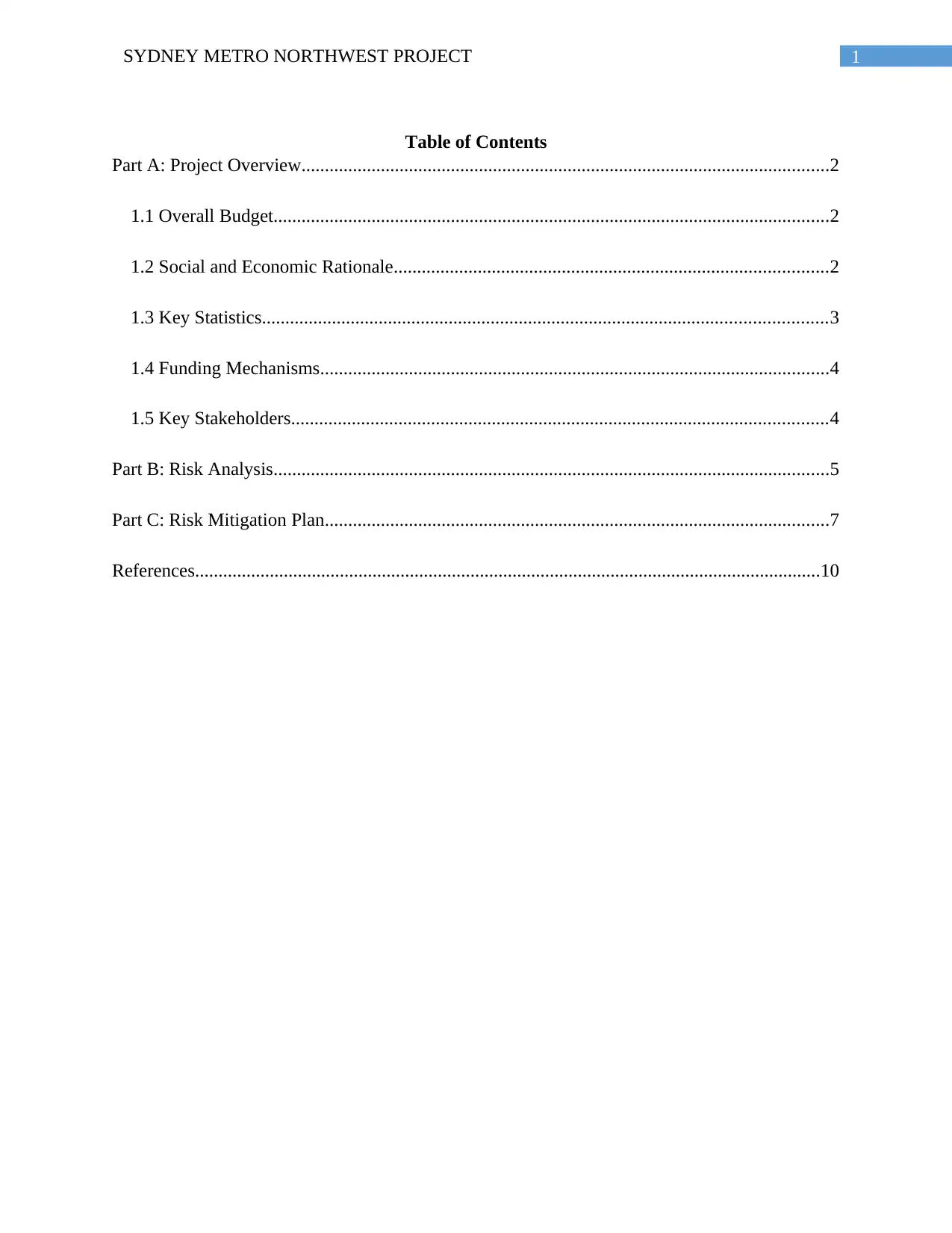
1SYDNEY METRO NORTHWEST PROJECT
Table of Contents
Part A: Project Overview.................................................................................................................2
1.1 Overall Budget.......................................................................................................................2
1.2 Social and Economic Rationale.............................................................................................2
1.3 Key Statistics.........................................................................................................................3
1.4 Funding Mechanisms.............................................................................................................4
1.5 Key Stakeholders...................................................................................................................4
Part B: Risk Analysis.......................................................................................................................5
Part C: Risk Mitigation Plan............................................................................................................7
References......................................................................................................................................10
Table of Contents
Part A: Project Overview.................................................................................................................2
1.1 Overall Budget.......................................................................................................................2
1.2 Social and Economic Rationale.............................................................................................2
1.3 Key Statistics.........................................................................................................................3
1.4 Funding Mechanisms.............................................................................................................4
1.5 Key Stakeholders...................................................................................................................4
Part B: Risk Analysis.......................................................................................................................5
Part C: Risk Mitigation Plan............................................................................................................7
References......................................................................................................................................10

2SYDNEY METRO NORTHWEST PROJECT
Part A: Project Overview
1.1 Overall Budget
During the design of the project, three major contracts were awared during the year 2013
and 2014 in order to deliver and operate the functions within Sydney Metro Northwest.
Stations and Tunnels Civil Works – A contract of $1.15 billion was awarded to CPB
John Holland Dragados. The primary purpose of the contract was to involve the building of the
15 kilometre long twin tunnels between Epping and Bella Vista (Sydneymetro.info 2019). It was
thus considered as one of the longest railway tunnels that had been ever built in Australia.
Viaduct and Surface Civil Works – A major contract of $340 million was awarded to
Impregilo-Salini joint venture on 17th December 2013. The contract had involved the building of
the four kilometre long elevated form of skytrain between Rouse Hill and Bella Vista (Clifton,
Mulley and Hensher 2014). This had also included a 270-metre cabled bridge at Windsor Road
situated at Rouse Hill.
Trains, Systems and Operations – The contract of $3.7 billion operators was majorly
awarded to Northwest Rapid Transit on 15th September 2014 (Chalker and Loosemore 2016).
The contract had involved the delivery of eight new railway stations, new metro trains in
Sydney, upgrading of the railway connection between Epping and Chatswood and also building a
major space for accomodating 4000 cars.
1.2 Social and Economic Rationale
The Sydney Metro Project is considered as one of the largest public transport project in
Australia that had approximately costed up to $12.5 billion. The benefits from the project is that
the new trains would have a capacity of carrying approximately 46,000 people within every hour
Part A: Project Overview
1.1 Overall Budget
During the design of the project, three major contracts were awared during the year 2013
and 2014 in order to deliver and operate the functions within Sydney Metro Northwest.
Stations and Tunnels Civil Works – A contract of $1.15 billion was awarded to CPB
John Holland Dragados. The primary purpose of the contract was to involve the building of the
15 kilometre long twin tunnels between Epping and Bella Vista (Sydneymetro.info 2019). It was
thus considered as one of the longest railway tunnels that had been ever built in Australia.
Viaduct and Surface Civil Works – A major contract of $340 million was awarded to
Impregilo-Salini joint venture on 17th December 2013. The contract had involved the building of
the four kilometre long elevated form of skytrain between Rouse Hill and Bella Vista (Clifton,
Mulley and Hensher 2014). This had also included a 270-metre cabled bridge at Windsor Road
situated at Rouse Hill.
Trains, Systems and Operations – The contract of $3.7 billion operators was majorly
awarded to Northwest Rapid Transit on 15th September 2014 (Chalker and Loosemore 2016).
The contract had involved the delivery of eight new railway stations, new metro trains in
Sydney, upgrading of the railway connection between Epping and Chatswood and also building a
major space for accomodating 4000 cars.
1.2 Social and Economic Rationale
The Sydney Metro Project is considered as one of the largest public transport project in
Australia that had approximately costed up to $12.5 billion. The benefits from the project is that
the new trains would have a capacity of carrying approximately 46,000 people within every hour
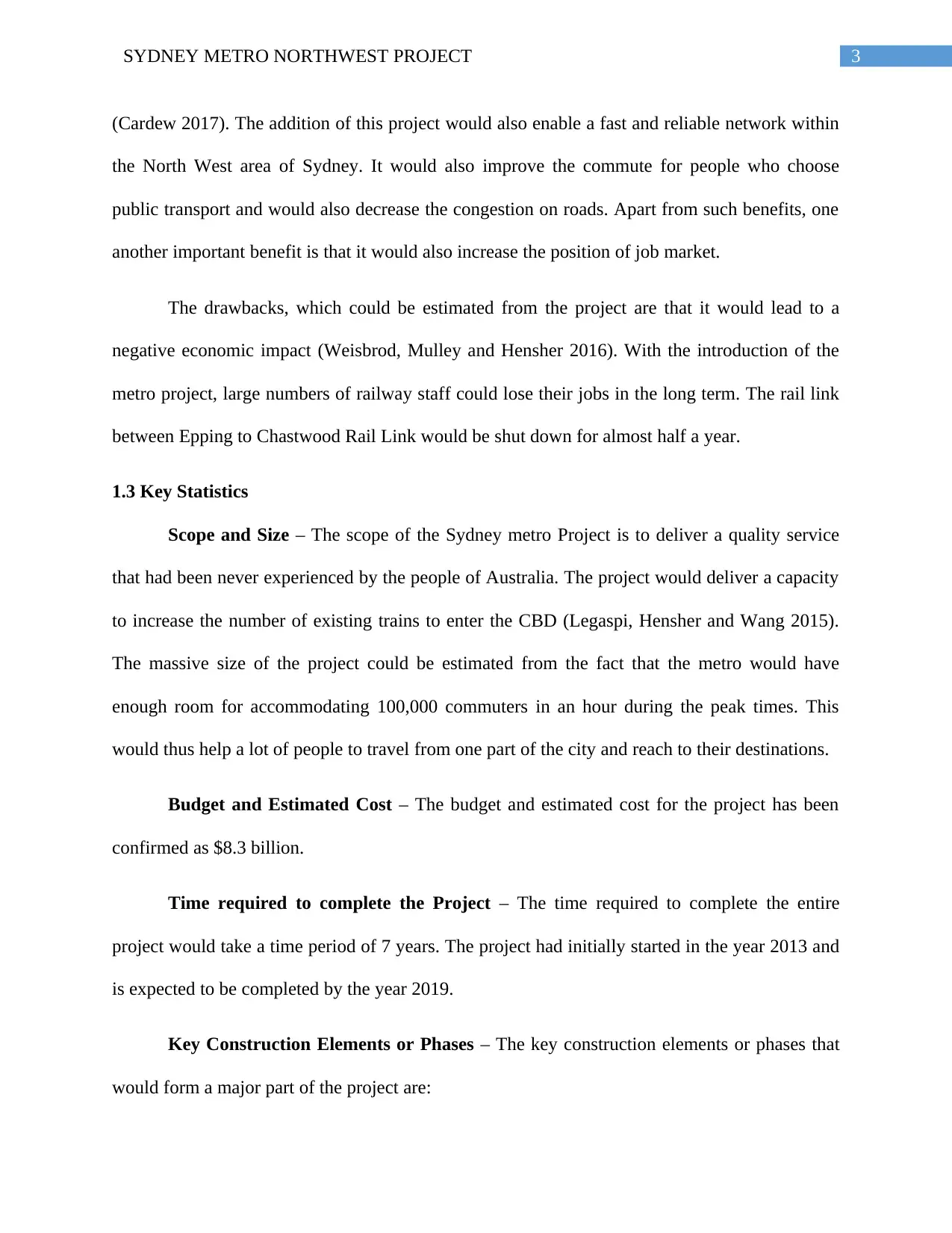
3SYDNEY METRO NORTHWEST PROJECT
(Cardew 2017). The addition of this project would also enable a fast and reliable network within
the North West area of Sydney. It would also improve the commute for people who choose
public transport and would also decrease the congestion on roads. Apart from such benefits, one
another important benefit is that it would also increase the position of job market.
The drawbacks, which could be estimated from the project are that it would lead to a
negative economic impact (Weisbrod, Mulley and Hensher 2016). With the introduction of the
metro project, large numbers of railway staff could lose their jobs in the long term. The rail link
between Epping to Chastwood Rail Link would be shut down for almost half a year.
1.3 Key Statistics
Scope and Size – The scope of the Sydney metro Project is to deliver a quality service
that had been never experienced by the people of Australia. The project would deliver a capacity
to increase the number of existing trains to enter the CBD (Legaspi, Hensher and Wang 2015).
The massive size of the project could be estimated from the fact that the metro would have
enough room for accommodating 100,000 commuters in an hour during the peak times. This
would thus help a lot of people to travel from one part of the city and reach to their destinations.
Budget and Estimated Cost – The budget and estimated cost for the project has been
confirmed as $8.3 billion.
Time required to complete the Project – The time required to complete the entire
project would take a time period of 7 years. The project had initially started in the year 2013 and
is expected to be completed by the year 2019.
Key Construction Elements or Phases – The key construction elements or phases that
would form a major part of the project are:
(Cardew 2017). The addition of this project would also enable a fast and reliable network within
the North West area of Sydney. It would also improve the commute for people who choose
public transport and would also decrease the congestion on roads. Apart from such benefits, one
another important benefit is that it would also increase the position of job market.
The drawbacks, which could be estimated from the project are that it would lead to a
negative economic impact (Weisbrod, Mulley and Hensher 2016). With the introduction of the
metro project, large numbers of railway staff could lose their jobs in the long term. The rail link
between Epping to Chastwood Rail Link would be shut down for almost half a year.
1.3 Key Statistics
Scope and Size – The scope of the Sydney metro Project is to deliver a quality service
that had been never experienced by the people of Australia. The project would deliver a capacity
to increase the number of existing trains to enter the CBD (Legaspi, Hensher and Wang 2015).
The massive size of the project could be estimated from the fact that the metro would have
enough room for accommodating 100,000 commuters in an hour during the peak times. This
would thus help a lot of people to travel from one part of the city and reach to their destinations.
Budget and Estimated Cost – The budget and estimated cost for the project has been
confirmed as $8.3 billion.
Time required to complete the Project – The time required to complete the entire
project would take a time period of 7 years. The project had initially started in the year 2013 and
is expected to be completed by the year 2019.
Key Construction Elements or Phases – The key construction elements or phases that
would form a major part of the project are:
Secure Best Marks with AI Grader
Need help grading? Try our AI Grader for instant feedback on your assignments.

4SYDNEY METRO NORTHWEST PROJECT
1. Strategic Assessment Phase
2. Investment Decision Phase
3. Phase of planning for approvals
4. Phase of Procurement
5. Delivery Phase
6. Operations Phase
Environmental benefits – The certain environmental benefits that have been addressed
while designing the project are based on the Construction Environmental Management
Framework (CEMF). Based on this framework, the government had set out standards for
environmental and sustainability management (Gharehbaghi and Sagoo 2016). This would also
help in ensuring the Sydney Metro and their contractors to comply as per the required planning
and statutory requirements.
1.4 Funding Mechanisms
The NSW and Australian Government are the initial funding partners for the Sydney
Metro Project. The government has also signed several contract to grant the funding for the
project. They had also secured a 20-month agreement over electric supply with ERM Power. A
total amount of $8.3 billion have been invested for the growth of the project.
1.5 Key Stakeholders
The key stakeholders that have been identified within the project include the Australian
and NSW Governments, the Minister for Transport and Infrastructure, Premier of NSW and
Minister for Western Sydney. Other stakeholders involved are the project manager, technicians,
1. Strategic Assessment Phase
2. Investment Decision Phase
3. Phase of planning for approvals
4. Phase of Procurement
5. Delivery Phase
6. Operations Phase
Environmental benefits – The certain environmental benefits that have been addressed
while designing the project are based on the Construction Environmental Management
Framework (CEMF). Based on this framework, the government had set out standards for
environmental and sustainability management (Gharehbaghi and Sagoo 2016). This would also
help in ensuring the Sydney Metro and their contractors to comply as per the required planning
and statutory requirements.
1.4 Funding Mechanisms
The NSW and Australian Government are the initial funding partners for the Sydney
Metro Project. The government has also signed several contract to grant the funding for the
project. They had also secured a 20-month agreement over electric supply with ERM Power. A
total amount of $8.3 billion have been invested for the growth of the project.
1.5 Key Stakeholders
The key stakeholders that have been identified within the project include the Australian
and NSW Governments, the Minister for Transport and Infrastructure, Premier of NSW and
Minister for Western Sydney. Other stakeholders involved are the project manager, technicians,
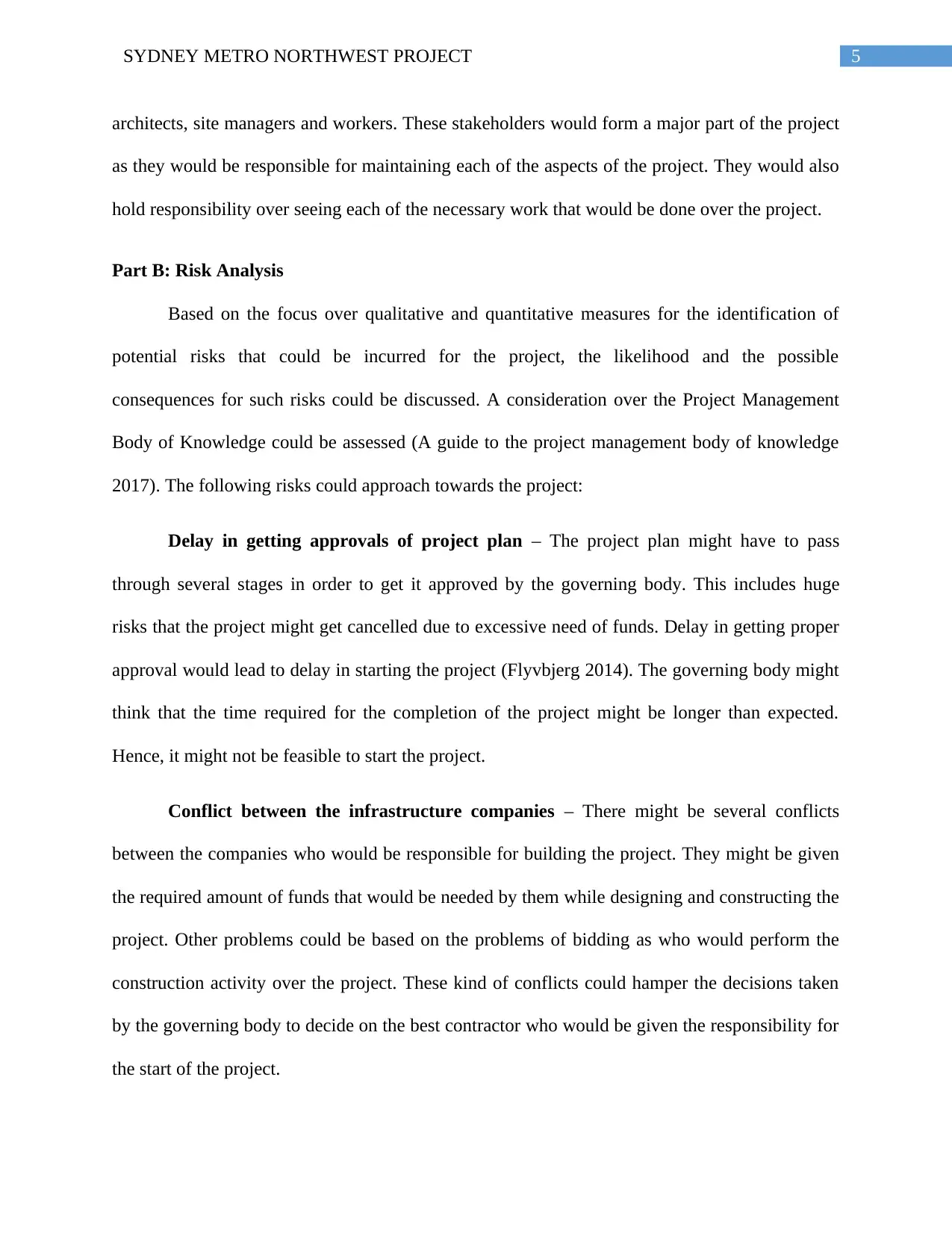
5SYDNEY METRO NORTHWEST PROJECT
architects, site managers and workers. These stakeholders would form a major part of the project
as they would be responsible for maintaining each of the aspects of the project. They would also
hold responsibility over seeing each of the necessary work that would be done over the project.
Part B: Risk Analysis
Based on the focus over qualitative and quantitative measures for the identification of
potential risks that could be incurred for the project, the likelihood and the possible
consequences for such risks could be discussed. A consideration over the Project Management
Body of Knowledge could be assessed (A guide to the project management body of knowledge
2017). The following risks could approach towards the project:
Delay in getting approvals of project plan – The project plan might have to pass
through several stages in order to get it approved by the governing body. This includes huge
risks that the project might get cancelled due to excessive need of funds. Delay in getting proper
approval would lead to delay in starting the project (Flyvbjerg 2014). The governing body might
think that the time required for the completion of the project might be longer than expected.
Hence, it might not be feasible to start the project.
Conflict between the infrastructure companies – There might be several conflicts
between the companies who would be responsible for building the project. They might be given
the required amount of funds that would be needed by them while designing and constructing the
project. Other problems could be based on the problems of bidding as who would perform the
construction activity over the project. These kind of conflicts could hamper the decisions taken
by the governing body to decide on the best contractor who would be given the responsibility for
the start of the project.
architects, site managers and workers. These stakeholders would form a major part of the project
as they would be responsible for maintaining each of the aspects of the project. They would also
hold responsibility over seeing each of the necessary work that would be done over the project.
Part B: Risk Analysis
Based on the focus over qualitative and quantitative measures for the identification of
potential risks that could be incurred for the project, the likelihood and the possible
consequences for such risks could be discussed. A consideration over the Project Management
Body of Knowledge could be assessed (A guide to the project management body of knowledge
2017). The following risks could approach towards the project:
Delay in getting approvals of project plan – The project plan might have to pass
through several stages in order to get it approved by the governing body. This includes huge
risks that the project might get cancelled due to excessive need of funds. Delay in getting proper
approval would lead to delay in starting the project (Flyvbjerg 2014). The governing body might
think that the time required for the completion of the project might be longer than expected.
Hence, it might not be feasible to start the project.
Conflict between the infrastructure companies – There might be several conflicts
between the companies who would be responsible for building the project. They might be given
the required amount of funds that would be needed by them while designing and constructing the
project. Other problems could be based on the problems of bidding as who would perform the
construction activity over the project. These kind of conflicts could hamper the decisions taken
by the governing body to decide on the best contractor who would be given the responsibility for
the start of the project.

6SYDNEY METRO NORTHWEST PROJECT
Disputes in acquisition of land – The government might not accept the issue of
providing sufficient land for the project. This would also be considered as a major factor for
delaying the project. The construction company would not be able to initiate the project without
a proper form of approval from the government body about the approval of land. This could
hamper and delay the start activity for the project.
Delay in sponsorship and fund gathering – There might not be a proper source for
funding of the project. The government might not accept the project plan or might not provide
enough funds for the start of the project (Jardine and Riley 2017). This might also prove to be a
negative impact over the project.
Technical Issues – Testing issues such as during the technical design over the project
could also be considered as a major risk for the project. Electric failure or low supply of electric
could also be considered as a major factor for the project (Hwang, Zhao and Yu 2016). The
instruments or devices that need to be used within the project might not be able to provide
sufficient output during the construction period. This could be a negative factor for the project
and might harm the project badly.
Unavoidable circumstances within the project – Several kind of unavoidable
circumstances could lead the project towards a negative outcome. There might be accidents
during the construction period that might put a negative impact over the project (Du et al. 2016).
Labour agitation based on payment disputes could arise during the construction period at any
point of time. On the other hand, negative impacts could also incur within the project during
unforeseen weather conditions such as heavy rains that could hamper the project and
construction activities. Due to heavy rains, the people involved within the construction would not
Disputes in acquisition of land – The government might not accept the issue of
providing sufficient land for the project. This would also be considered as a major factor for
delaying the project. The construction company would not be able to initiate the project without
a proper form of approval from the government body about the approval of land. This could
hamper and delay the start activity for the project.
Delay in sponsorship and fund gathering – There might not be a proper source for
funding of the project. The government might not accept the project plan or might not provide
enough funds for the start of the project (Jardine and Riley 2017). This might also prove to be a
negative impact over the project.
Technical Issues – Testing issues such as during the technical design over the project
could also be considered as a major risk for the project. Electric failure or low supply of electric
could also be considered as a major factor for the project (Hwang, Zhao and Yu 2016). The
instruments or devices that need to be used within the project might not be able to provide
sufficient output during the construction period. This could be a negative factor for the project
and might harm the project badly.
Unavoidable circumstances within the project – Several kind of unavoidable
circumstances could lead the project towards a negative outcome. There might be accidents
during the construction period that might put a negative impact over the project (Du et al. 2016).
Labour agitation based on payment disputes could arise during the construction period at any
point of time. On the other hand, negative impacts could also incur within the project during
unforeseen weather conditions such as heavy rains that could hamper the project and
construction activities. Due to heavy rains, the people involved within the construction would not
Paraphrase This Document
Need a fresh take? Get an instant paraphrase of this document with our AI Paraphraser

7SYDNEY METRO NORTHWEST PROJECT
be able to initiate the project activities. Hence, this could lead to tremendous negative outcomes
for the project.
be able to initiate the project activities. Hence, this could lead to tremendous negative outcomes
for the project.

8SYDNEY METRO NORTHWEST PROJECT
Risks Likelihood of Risk Consequence of Risks
Delay in getting an approval of the
project report
Low High
Conflict between the infrastructure
provider companies
Low High
Disputes within Acquisition of
Land
High High
Delay in getting sponsors and
approval of funds
Low High
Technical issues during performing
of construction operations
Low Medium
Unavoidable circumstances such as
constructional accidents, terror
attacks or worst weather conditions
Low High
Part C: Risk Mitigation Plan
Based on the discussed scenarios of risks, it can be discussed that a proper form of
mitigation plan would be taken to assess each of the risks. Based on the assessment over each of
the discussed scenarios of risks, a proper mitigation plan could be framed. The mitigation plan
for the above risks could be described as:
Delay in getting approvals of project plan – The government body should be
approached with more efforts. They should be provided with the exact details over each of the
activities, the cost of resources and other aspects in relation to the project (Qazi et al. 2016). The
governing body and other stakeholders involved within the project should be given all the
possible details based on which they would be able to understand the scenario and thus give a
proper approval to the project. The financial plan over the project should be discussed with the
stakeholder groups.
Risks Likelihood of Risk Consequence of Risks
Delay in getting an approval of the
project report
Low High
Conflict between the infrastructure
provider companies
Low High
Disputes within Acquisition of
Land
High High
Delay in getting sponsors and
approval of funds
Low High
Technical issues during performing
of construction operations
Low Medium
Unavoidable circumstances such as
constructional accidents, terror
attacks or worst weather conditions
Low High
Part C: Risk Mitigation Plan
Based on the discussed scenarios of risks, it can be discussed that a proper form of
mitigation plan would be taken to assess each of the risks. Based on the assessment over each of
the discussed scenarios of risks, a proper mitigation plan could be framed. The mitigation plan
for the above risks could be described as:
Delay in getting approvals of project plan – The government body should be
approached with more efforts. They should be provided with the exact details over each of the
activities, the cost of resources and other aspects in relation to the project (Qazi et al. 2016). The
governing body and other stakeholders involved within the project should be given all the
possible details based on which they would be able to understand the scenario and thus give a
proper approval to the project. The financial plan over the project should be discussed with the
stakeholder groups.
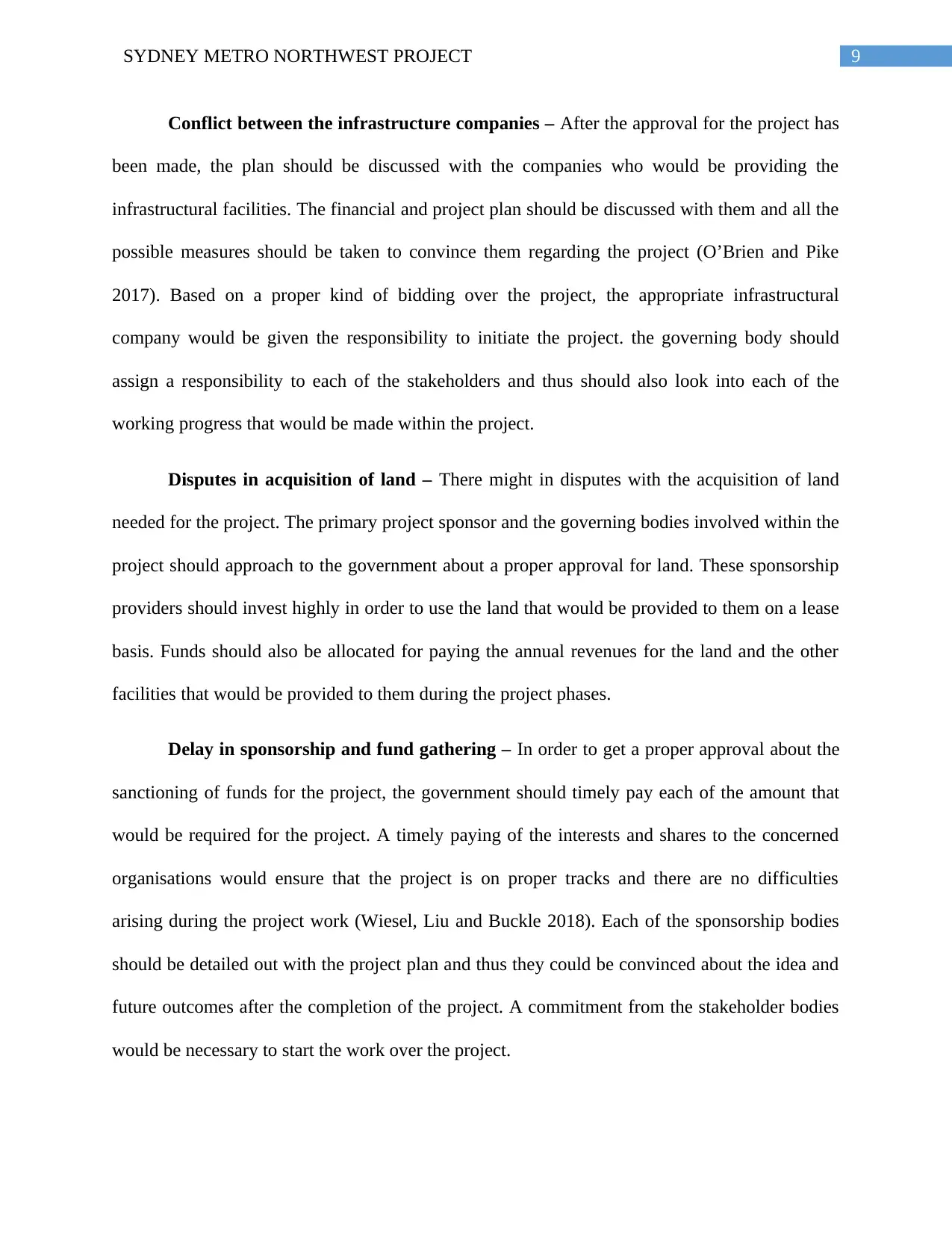
9SYDNEY METRO NORTHWEST PROJECT
Conflict between the infrastructure companies – After the approval for the project has
been made, the plan should be discussed with the companies who would be providing the
infrastructural facilities. The financial and project plan should be discussed with them and all the
possible measures should be taken to convince them regarding the project (O’Brien and Pike
2017). Based on a proper kind of bidding over the project, the appropriate infrastructural
company would be given the responsibility to initiate the project. the governing body should
assign a responsibility to each of the stakeholders and thus should also look into each of the
working progress that would be made within the project.
Disputes in acquisition of land – There might in disputes with the acquisition of land
needed for the project. The primary project sponsor and the governing bodies involved within the
project should approach to the government about a proper approval for land. These sponsorship
providers should invest highly in order to use the land that would be provided to them on a lease
basis. Funds should also be allocated for paying the annual revenues for the land and the other
facilities that would be provided to them during the project phases.
Delay in sponsorship and fund gathering – In order to get a proper approval about the
sanctioning of funds for the project, the government should timely pay each of the amount that
would be required for the project. A timely paying of the interests and shares to the concerned
organisations would ensure that the project is on proper tracks and there are no difficulties
arising during the project work (Wiesel, Liu and Buckle 2018). Each of the sponsorship bodies
should be detailed out with the project plan and thus they could be convinced about the idea and
future outcomes after the completion of the project. A commitment from the stakeholder bodies
would be necessary to start the work over the project.
Conflict between the infrastructure companies – After the approval for the project has
been made, the plan should be discussed with the companies who would be providing the
infrastructural facilities. The financial and project plan should be discussed with them and all the
possible measures should be taken to convince them regarding the project (O’Brien and Pike
2017). Based on a proper kind of bidding over the project, the appropriate infrastructural
company would be given the responsibility to initiate the project. the governing body should
assign a responsibility to each of the stakeholders and thus should also look into each of the
working progress that would be made within the project.
Disputes in acquisition of land – There might in disputes with the acquisition of land
needed for the project. The primary project sponsor and the governing bodies involved within the
project should approach to the government about a proper approval for land. These sponsorship
providers should invest highly in order to use the land that would be provided to them on a lease
basis. Funds should also be allocated for paying the annual revenues for the land and the other
facilities that would be provided to them during the project phases.
Delay in sponsorship and fund gathering – In order to get a proper approval about the
sanctioning of funds for the project, the government should timely pay each of the amount that
would be required for the project. A timely paying of the interests and shares to the concerned
organisations would ensure that the project is on proper tracks and there are no difficulties
arising during the project work (Wiesel, Liu and Buckle 2018). Each of the sponsorship bodies
should be detailed out with the project plan and thus they could be convinced about the idea and
future outcomes after the completion of the project. A commitment from the stakeholder bodies
would be necessary to start the work over the project.
Secure Best Marks with AI Grader
Need help grading? Try our AI Grader for instant feedback on your assignments.
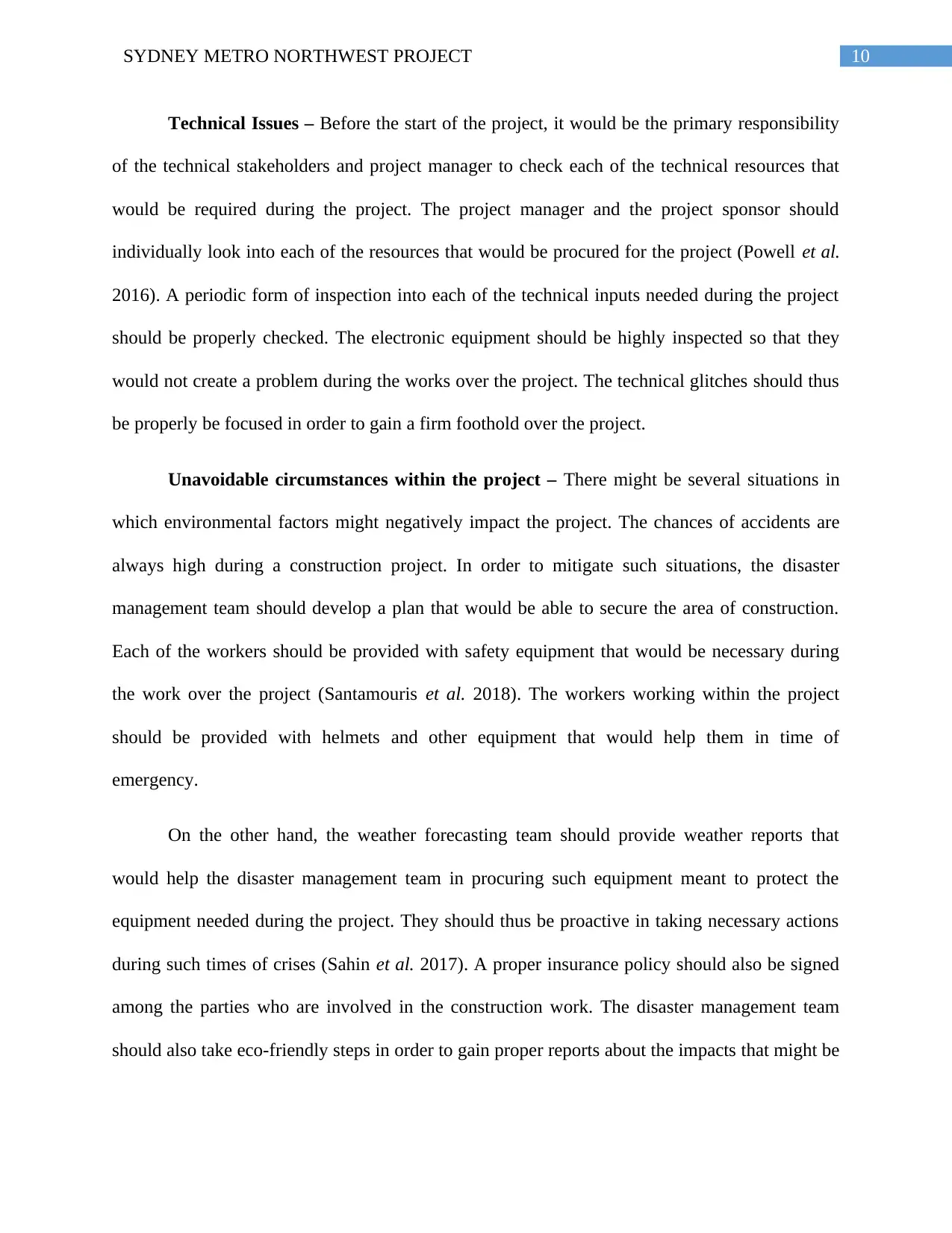
10SYDNEY METRO NORTHWEST PROJECT
Technical Issues – Before the start of the project, it would be the primary responsibility
of the technical stakeholders and project manager to check each of the technical resources that
would be required during the project. The project manager and the project sponsor should
individually look into each of the resources that would be procured for the project (Powell et al.
2016). A periodic form of inspection into each of the technical inputs needed during the project
should be properly checked. The electronic equipment should be highly inspected so that they
would not create a problem during the works over the project. The technical glitches should thus
be properly be focused in order to gain a firm foothold over the project.
Unavoidable circumstances within the project – There might be several situations in
which environmental factors might negatively impact the project. The chances of accidents are
always high during a construction project. In order to mitigate such situations, the disaster
management team should develop a plan that would be able to secure the area of construction.
Each of the workers should be provided with safety equipment that would be necessary during
the work over the project (Santamouris et al. 2018). The workers working within the project
should be provided with helmets and other equipment that would help them in time of
emergency.
On the other hand, the weather forecasting team should provide weather reports that
would help the disaster management team in procuring such equipment meant to protect the
equipment needed during the project. They should thus be proactive in taking necessary actions
during such times of crises (Sahin et al. 2017). A proper insurance policy should also be signed
among the parties who are involved in the construction work. The disaster management team
should also take eco-friendly steps in order to gain proper reports about the impacts that might be
Technical Issues – Before the start of the project, it would be the primary responsibility
of the technical stakeholders and project manager to check each of the technical resources that
would be required during the project. The project manager and the project sponsor should
individually look into each of the resources that would be procured for the project (Powell et al.
2016). A periodic form of inspection into each of the technical inputs needed during the project
should be properly checked. The electronic equipment should be highly inspected so that they
would not create a problem during the works over the project. The technical glitches should thus
be properly be focused in order to gain a firm foothold over the project.
Unavoidable circumstances within the project – There might be several situations in
which environmental factors might negatively impact the project. The chances of accidents are
always high during a construction project. In order to mitigate such situations, the disaster
management team should develop a plan that would be able to secure the area of construction.
Each of the workers should be provided with safety equipment that would be necessary during
the work over the project (Santamouris et al. 2018). The workers working within the project
should be provided with helmets and other equipment that would help them in time of
emergency.
On the other hand, the weather forecasting team should provide weather reports that
would help the disaster management team in procuring such equipment meant to protect the
equipment needed during the project. They should thus be proactive in taking necessary actions
during such times of crises (Sahin et al. 2017). A proper insurance policy should also be signed
among the parties who are involved in the construction work. The disaster management team
should also take eco-friendly steps in order to gain proper reports about the impacts that might be

11SYDNEY METRO NORTHWEST PROJECT
made during the project. This would also help in ensuring the performing of work over the
project in a successful manner.
made during the project. This would also help in ensuring the performing of work over the
project in a successful manner.
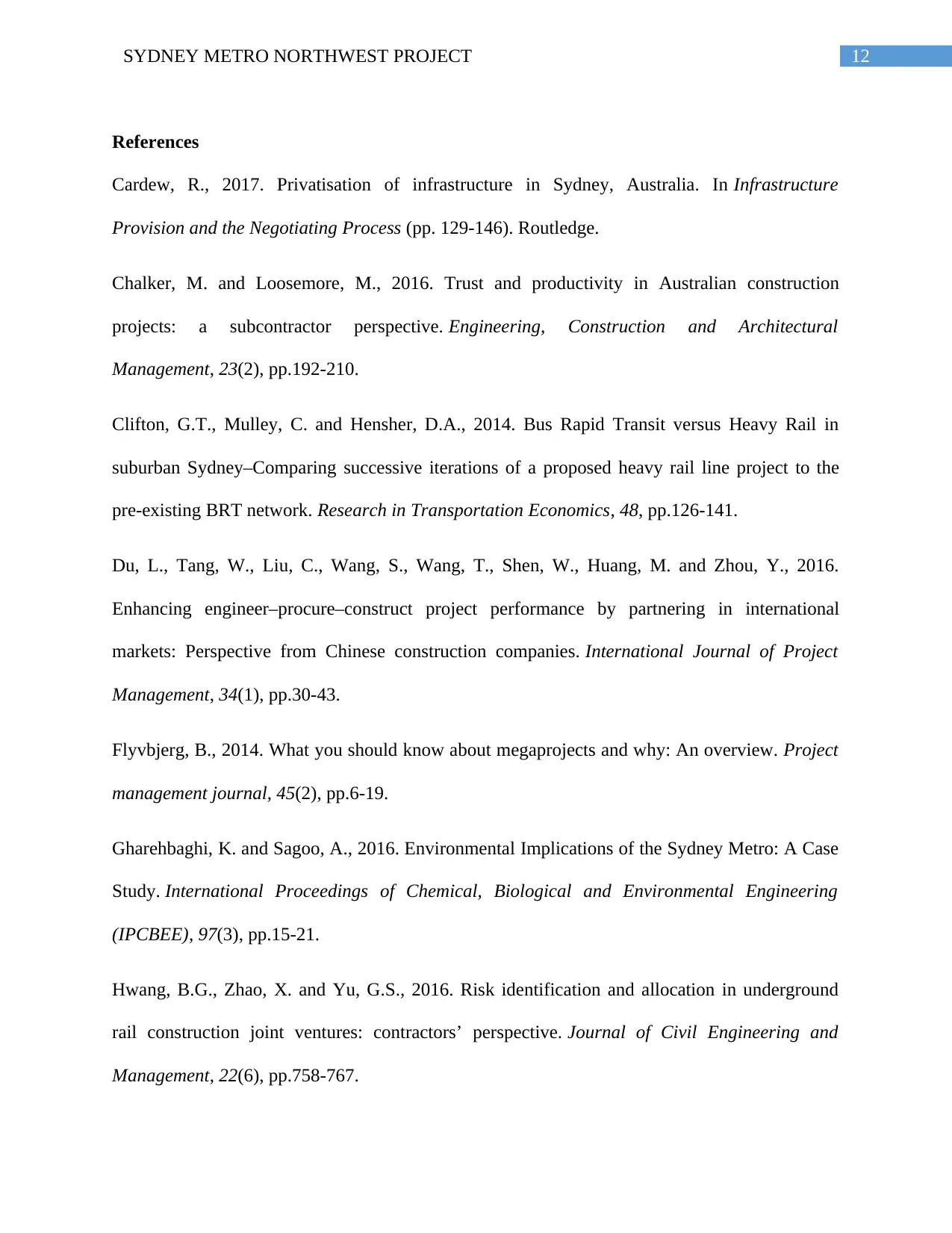
12SYDNEY METRO NORTHWEST PROJECT
References
Cardew, R., 2017. Privatisation of infrastructure in Sydney, Australia. In Infrastructure
Provision and the Negotiating Process (pp. 129-146). Routledge.
Chalker, M. and Loosemore, M., 2016. Trust and productivity in Australian construction
projects: a subcontractor perspective. Engineering, Construction and Architectural
Management, 23(2), pp.192-210.
Clifton, G.T., Mulley, C. and Hensher, D.A., 2014. Bus Rapid Transit versus Heavy Rail in
suburban Sydney–Comparing successive iterations of a proposed heavy rail line project to the
pre-existing BRT network. Research in Transportation Economics, 48, pp.126-141.
Du, L., Tang, W., Liu, C., Wang, S., Wang, T., Shen, W., Huang, M. and Zhou, Y., 2016.
Enhancing engineer–procure–construct project performance by partnering in international
markets: Perspective from Chinese construction companies. International Journal of Project
Management, 34(1), pp.30-43.
Flyvbjerg, B., 2014. What you should know about megaprojects and why: An overview. Project
management journal, 45(2), pp.6-19.
Gharehbaghi, K. and Sagoo, A., 2016. Environmental Implications of the Sydney Metro: A Case
Study. International Proceedings of Chemical, Biological and Environmental Engineering
(IPCBEE), 97(3), pp.15-21.
Hwang, B.G., Zhao, X. and Yu, G.S., 2016. Risk identification and allocation in underground
rail construction joint ventures: contractors’ perspective. Journal of Civil Engineering and
Management, 22(6), pp.758-767.
References
Cardew, R., 2017. Privatisation of infrastructure in Sydney, Australia. In Infrastructure
Provision and the Negotiating Process (pp. 129-146). Routledge.
Chalker, M. and Loosemore, M., 2016. Trust and productivity in Australian construction
projects: a subcontractor perspective. Engineering, Construction and Architectural
Management, 23(2), pp.192-210.
Clifton, G.T., Mulley, C. and Hensher, D.A., 2014. Bus Rapid Transit versus Heavy Rail in
suburban Sydney–Comparing successive iterations of a proposed heavy rail line project to the
pre-existing BRT network. Research in Transportation Economics, 48, pp.126-141.
Du, L., Tang, W., Liu, C., Wang, S., Wang, T., Shen, W., Huang, M. and Zhou, Y., 2016.
Enhancing engineer–procure–construct project performance by partnering in international
markets: Perspective from Chinese construction companies. International Journal of Project
Management, 34(1), pp.30-43.
Flyvbjerg, B., 2014. What you should know about megaprojects and why: An overview. Project
management journal, 45(2), pp.6-19.
Gharehbaghi, K. and Sagoo, A., 2016. Environmental Implications of the Sydney Metro: A Case
Study. International Proceedings of Chemical, Biological and Environmental Engineering
(IPCBEE), 97(3), pp.15-21.
Hwang, B.G., Zhao, X. and Yu, G.S., 2016. Risk identification and allocation in underground
rail construction joint ventures: contractors’ perspective. Journal of Civil Engineering and
Management, 22(6), pp.758-767.
Paraphrase This Document
Need a fresh take? Get an instant paraphrase of this document with our AI Paraphraser

13SYDNEY METRO NORTHWEST PROJECT
Jardine, D. and Riley, M., 2017. Tunnel vision: Optimising procurement models to deliver
successful tunnelling projects. In 16th Australasian Tunnelling Conference 2017: Challenging
Underground Space: Bigger, Better, More (p. 632). Engineers Australia.
Legaspi, J., Hensher, D. and Wang, B., 2015. Estimating the wider economic benefits of
transport investments: The case of the Sydney North West Rail Link project. Case Studies on
Transport Policy, 3(2), pp.182-195.
O’Brien, P. and Pike, A., 2017. 10. The financialization and governance of
infrastructure. Handbook on the Geographies of Money and Finance, p.223.
Powell, J.P., Fraszczyk, A., Cheong, C.N. and Yeung, H.K., 2016. Potential benefits and
obstacles of implementing driverless train operation on the tyne and wear metro: a simulation
exercise. Urban Rail Transit, 2(3-4), pp.114-127.
Project Management Institute. (2017). A guide to the project management body of knowledge
(PMBOK guide). (6th ed.). Newton Square, PA: Project Management Institute.
Qazi, A., Quigley, J., Dickson, A. and Kirytopoulos, K., 2016. Project Complexity and Risk
Management (ProCRiM): Towards modelling project complexity driven risk paths in
construction projects. International Journal of Project Management, 34(7), pp.1183-1198.
Sahin, O., Stewart, R.A., Giurco, D. and Porter, M.G., 2017. Renewable hydropower generation
as a co-benefit of balanced urban water portfolio management and flood risk
mitigation. Renewable and Sustainable Energy Reviews, 68, pp.1076-1087.
Jardine, D. and Riley, M., 2017. Tunnel vision: Optimising procurement models to deliver
successful tunnelling projects. In 16th Australasian Tunnelling Conference 2017: Challenging
Underground Space: Bigger, Better, More (p. 632). Engineers Australia.
Legaspi, J., Hensher, D. and Wang, B., 2015. Estimating the wider economic benefits of
transport investments: The case of the Sydney North West Rail Link project. Case Studies on
Transport Policy, 3(2), pp.182-195.
O’Brien, P. and Pike, A., 2017. 10. The financialization and governance of
infrastructure. Handbook on the Geographies of Money and Finance, p.223.
Powell, J.P., Fraszczyk, A., Cheong, C.N. and Yeung, H.K., 2016. Potential benefits and
obstacles of implementing driverless train operation on the tyne and wear metro: a simulation
exercise. Urban Rail Transit, 2(3-4), pp.114-127.
Project Management Institute. (2017). A guide to the project management body of knowledge
(PMBOK guide). (6th ed.). Newton Square, PA: Project Management Institute.
Qazi, A., Quigley, J., Dickson, A. and Kirytopoulos, K., 2016. Project Complexity and Risk
Management (ProCRiM): Towards modelling project complexity driven risk paths in
construction projects. International Journal of Project Management, 34(7), pp.1183-1198.
Sahin, O., Stewart, R.A., Giurco, D. and Porter, M.G., 2017. Renewable hydropower generation
as a co-benefit of balanced urban water portfolio management and flood risk
mitigation. Renewable and Sustainable Energy Reviews, 68, pp.1076-1087.
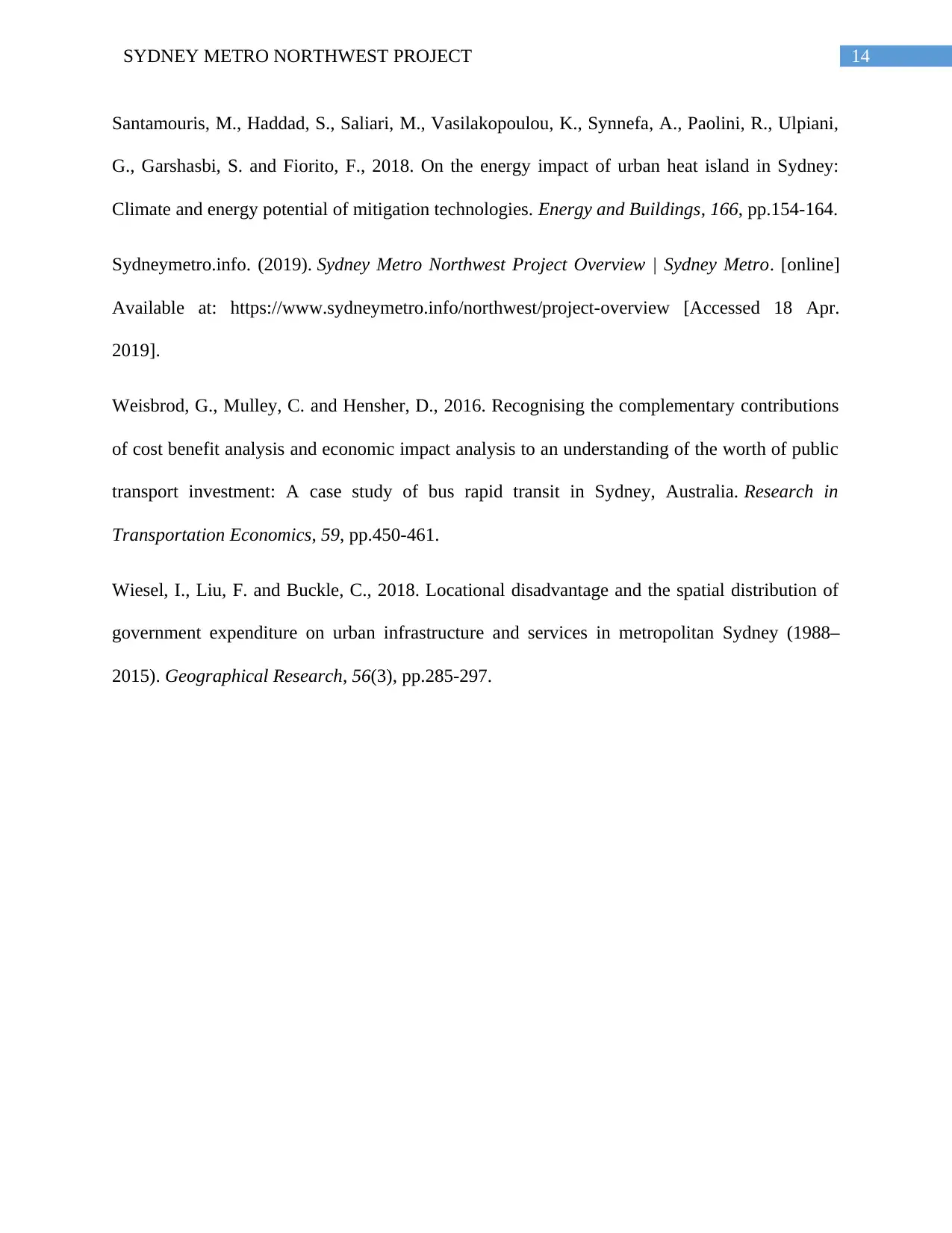
14SYDNEY METRO NORTHWEST PROJECT
Santamouris, M., Haddad, S., Saliari, M., Vasilakopoulou, K., Synnefa, A., Paolini, R., Ulpiani,
G., Garshasbi, S. and Fiorito, F., 2018. On the energy impact of urban heat island in Sydney:
Climate and energy potential of mitigation technologies. Energy and Buildings, 166, pp.154-164.
Sydneymetro.info. (2019). Sydney Metro Northwest Project Overview | Sydney Metro. [online]
Available at: https://www.sydneymetro.info/northwest/project-overview [Accessed 18 Apr.
2019].
Weisbrod, G., Mulley, C. and Hensher, D., 2016. Recognising the complementary contributions
of cost benefit analysis and economic impact analysis to an understanding of the worth of public
transport investment: A case study of bus rapid transit in Sydney, Australia. Research in
Transportation Economics, 59, pp.450-461.
Wiesel, I., Liu, F. and Buckle, C., 2018. Locational disadvantage and the spatial distribution of
government expenditure on urban infrastructure and services in metropolitan Sydney (1988–
2015). Geographical Research, 56(3), pp.285-297.
Santamouris, M., Haddad, S., Saliari, M., Vasilakopoulou, K., Synnefa, A., Paolini, R., Ulpiani,
G., Garshasbi, S. and Fiorito, F., 2018. On the energy impact of urban heat island in Sydney:
Climate and energy potential of mitigation technologies. Energy and Buildings, 166, pp.154-164.
Sydneymetro.info. (2019). Sydney Metro Northwest Project Overview | Sydney Metro. [online]
Available at: https://www.sydneymetro.info/northwest/project-overview [Accessed 18 Apr.
2019].
Weisbrod, G., Mulley, C. and Hensher, D., 2016. Recognising the complementary contributions
of cost benefit analysis and economic impact analysis to an understanding of the worth of public
transport investment: A case study of bus rapid transit in Sydney, Australia. Research in
Transportation Economics, 59, pp.450-461.
Wiesel, I., Liu, F. and Buckle, C., 2018. Locational disadvantage and the spatial distribution of
government expenditure on urban infrastructure and services in metropolitan Sydney (1988–
2015). Geographical Research, 56(3), pp.285-297.
1 out of 15
Your All-in-One AI-Powered Toolkit for Academic Success.
+13062052269
info@desklib.com
Available 24*7 on WhatsApp / Email
![[object Object]](/_next/static/media/star-bottom.7253800d.svg)
Unlock your academic potential
© 2024 | Zucol Services PVT LTD | All rights reserved.

